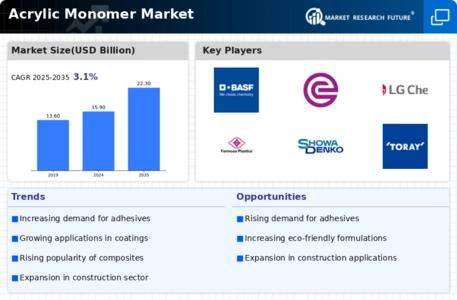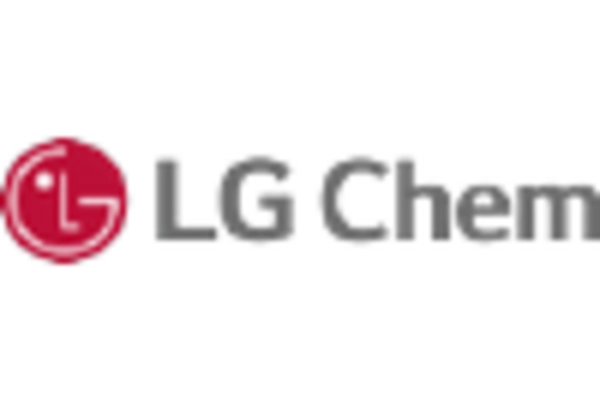Growth in the Renewable Energy Sector
The Acrylic Monomer Market is witnessing growth driven by the renewable energy sector, particularly in the production of solar panels and wind turbine components. Acrylic monomers are increasingly utilized in the manufacturing of lightweight and durable materials that are essential for these applications. In 2025, the demand for acrylic-based composites is anticipated to rise, as the push for sustainable energy solutions continues to gain momentum. This trend is likely to create new opportunities for manufacturers within the Acrylic Monomer Market, as they adapt their product offerings to cater to the specific needs of the renewable energy sector. The intersection of acrylic monomers and renewable technologies presents a promising avenue for future growth.
Expansion of the Paints and Inks Sector
The Acrylic Monomer Market is significantly influenced by the expansion of the paints and inks sector, which is experiencing a renaissance due to evolving consumer preferences and regulatory changes. The shift towards high-quality, low-VOC paints is fostering an environment conducive to the growth of acrylic monomers. In 2025, the demand for acrylic-based inks is expected to rise, driven by their superior adhesion and flexibility. This trend is further supported by the increasing adoption of digital printing technologies, which require specialized inks that often utilize acrylic monomers. As a result, the Acrylic Monomer Market is poised for growth, with manufacturers focusing on developing innovative products that meet the stringent requirements of modern applications.
Rising Demand for Coatings and Adhesives
The Acrylic Monomer Market experiences a notable surge in demand for coatings and adhesives, driven by the expanding construction and automotive sectors. The increasing need for durable and high-performance materials in these industries propels the consumption of acrylic monomers. In 2025, the coatings segment is projected to account for a substantial share of the market, reflecting a growing preference for water-based and eco-friendly solutions. This trend aligns with the industry's shift towards sustainability, as manufacturers seek to reduce volatile organic compounds in their products. Consequently, the Acrylic Monomer Market is likely to witness a robust growth trajectory, as innovations in formulation and application techniques enhance the performance characteristics of acrylic-based products.
Increasing Applications in Medical Devices
The Acrylic Monomer Market is experiencing a notable increase in applications within the medical devices sector, driven by the demand for biocompatible materials. Acrylic monomers are utilized in the production of various medical devices, including dental products, contact lenses, and surgical instruments. In 2025, the market is expected to see a rise in the use of acrylic-based materials, as healthcare providers seek innovative solutions that enhance patient outcomes. This trend is further supported by regulatory advancements that promote the use of safe and effective materials in medical applications. Consequently, the Acrylic Monomer Market is likely to expand, as manufacturers focus on developing specialized products that meet the stringent requirements of the healthcare sector.
Technological Innovations in Polymer Production
Technological innovations in polymer production are reshaping the Acrylic Monomer Market, as advancements in manufacturing processes enhance efficiency and reduce costs. The introduction of new catalysts and reaction conditions is enabling the production of acrylic monomers with improved properties, such as higher purity and better performance characteristics. In 2025, the market is likely to benefit from these innovations, as manufacturers strive to meet the increasing demand for high-performance polymers in various applications. Furthermore, the integration of automation and digital technologies in production facilities is expected to streamline operations, thereby increasing output and reducing waste. This evolution in production technology is a key driver for the Acrylic Monomer Market, fostering competitiveness and sustainability.

















Leave a Comment